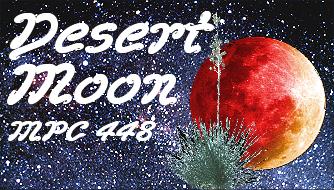Journey
to the Antumbra:
The
Annular Solar Eclipse of
May
20, 2012
For many years it has been know that on May 20, 2012, an
annular solar eclipse would sweep across the Pacific Ocean,
ending its journey across the Earth in the panhandle of Texas.
While annular eclipses are no where near as interesting as a
total solar eclipse, its proximity to Las Cruces meant that we
could not ignore this none-the-less rare event. So the
co-directors of the Observatory, Berton and Janet Stevens,
started planning to observe this event.
Standard procedure for any eclipse is to stay mobile. This
would be Bert's ninth attempt to be near the centerline of a
solar eclipse and this is one of a number of rules that he
developed for successfully observing these events. To become
stuck at a fixed location usually brings clouds and a lack of
observation.

The eclipse entered the United States in northern
California, slid over Nevada, northern Arizona, northern New
Mexico, and into Texas. The western end was often cloudy, as
was the eastern end. That left the middle, with the Arizona
area being the most likely to be clear. While climatic
forecasts are interesting, it is the actual weather that is
important. Weather Underground provides predictions some eleven
days out. If the weather was clear along the entire path, it
would be most efficient to observe in Albuquerque, the closest
location to Las Cruces that was easiest to reach.
The forecast from weather Underground was mostly for clear
skies, but it would occasionally jump to cloudy and then the
next day back to clear . Bert contacted the Albuquerque
Astronomical Society (TAAS) to see what they had arranged for
the event. They had worked with Bernalillo County to arrange a
viewing area near the Pavillion for the Hard Rock Casino
Presents, just south of the airport. They had set aside an area
specifically for astronomers just half a mile from the
centerline, and this sounded like a good option.
Even with this good option, we also continued to look at
sites further west along the path. Three additional sites were
selected in New Mexico and Arizona. These were US 491 near
Gallup, Chinle, AZ, and Page, AZ, near Glen Canyon Dam. This
last location is where Nils Allen would be observing the
eclipse, but was another six hours driving and the outlook that
Nils was at was almost five miles from the centerline, which
would make the Moon appear slightly off-center. The centerline
actually ran through nearby Page, so we looked at that as an
option as well.
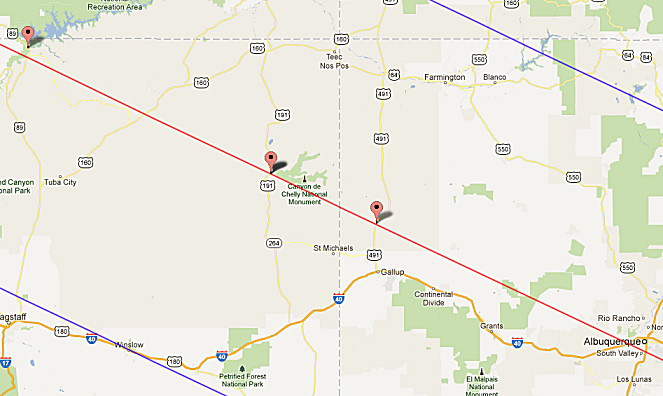
As the day of the eclipse got closer, I ran exposure tests
to verify the correct exposure time for photographing the
eclipse. Using color negative film provided a wider exposure
range that would still produce acceptable prints. While the
tests were done with the Sun near overhead, the eclipse would
be low in the west, so I added two stops to the estimated
exposure. The test pictures produced good images with a Meade
ETX-125 with a solar filter over the front.
A few days before the eclipse, the forecast seemed to
stabilize as clear in Albuquerque. We planned to travel up
there the day before to be ready to make the final weather
decision, so we would have plenty of time to travel westward,
if necessary. The day before the eclipse we packed up the car,
the telescopes, and ourselves and headed up north. The trip was
uneventful.
We settled into our hotel and connected to the Internet to
get the latest weather. While further south and west would be
clear, moisture was working into the Albuquerque area from the
northeast. This could create clouds and even thunderstorms in
Albuquerque and northeast. With the weather being uncertain, we
decided not to travel any further west and throw our lot in
with the Albuquerque group.
Sunday dawned clear and with our observing site committed,
we did a little shopping in a local mall. We then headed back
to the hotel and picked up the rest of the equipment and headed
out to the observing site. It was rather warm as we arrived at
the site. We advised the traffic director that we were amateur
astronomers and they directed us into the west end of the
parking lot where other amateurs were already starting to set
up. We drove around and picked an observing site that had a
good view of the west.
We started setting up the equipment. Janet had her six-inch
f/8 Edmund Scientific Newtonian with a full-aperture solar
filter. She also had a a Coronado PST. I was using her ETX-125,
also with a full aperture solar filter. The camera was at the
prime focus of the instrument. We also had a camcorder with a
solar filter to try to record the eclipse on video. All the
equipment was in good shape and working.
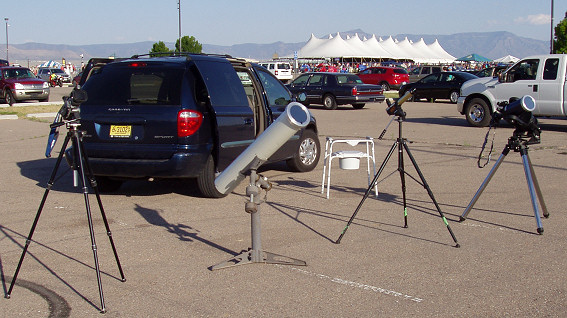
As first contact approached, the sky to the west was clear,
but there were a few clouds off to the east. They were not
coming our way. Our gamble had paid-off and we were ready to
observe the eclipse.
The Sun was eighteen degrees up at first contact (6:28:28
p.m. MDT). We watched the Moon slowly creep onto the Sun's
disc. The view was excellent with all the instruments, Bert had
inadvertently left the cable releases at home, so Bert used the
self-timer on the camera to allow the mirror to come up well
before the exposure started. This greatly reduced the vibration
from mirror-slap, but there was only one delay setting of
fifteen seconds available, so exposures needed to be started
fifteen seconds early. Catching second or third contact would
just be luck.
We had a few visitors as the Moon slid onto the Sun, we gave
them views of the eclipse with the six-inch and the PST. We
also gave out a few pair of eclipse-glasses that we had brought
along, They had run out of them in the public viewing area,
where they had a huge tent, food, and most importantly,
port-a-potties. It also kept most of the public out of the
astronomers' area since they had solar telescopes set up over
there for viewing.
Janet was viewing the eclipse through the PST and her
six-inch with a solar filter. She remarked about the difference
in the two views. Through the 6-inch, in visible light, the
sunspots were clearly visible. In the PST, in hydrogen-alpha
light, the sunspots almost completely disappeared.
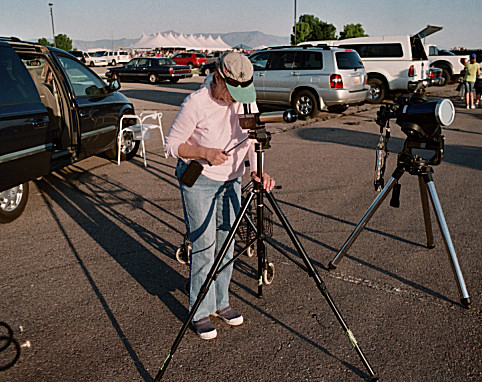
The Sun finally started to stretch its arms around the Moon
as second contact approached. At 7:33:42 p.m. the end of the
cusps came together as the Moon moved completely onto the Sun's
surface at an altitude of only 5.5 degrees. Even with most of
the Sun blocked, it was still quite bright. Normally, things
would seems bit dim with the Sun overhead during an eclipse,
but with the Sun this low, it did not seem so unusual, but it
still seemed a little murky.
Mid-eclipse came at 7:35:55 p.m. with the Sun and Moon
forming a perfect circle in the sky, only 5.1 degrees above the
horizon. Switching between photographing, and viewing, I
sneaked a peak at the eclipsed Sun without a filter. It was
amazing to see this brilliant ring of fire hanging just a above
the west-northwestern horizon. I quickly brought the solar
filter back in front of my eyes.
After a brief four minutes and twenty-seven seconds, the
eastern edge of the Solar ring broke apart as the Moon began to
move off the Sun at 7:38:08, a scant 4.7 degrees above the
horizon. A giant cheer went up from everyone watching the
event. A helicopter flew over taking pictures of the crowd
assembled for the event.
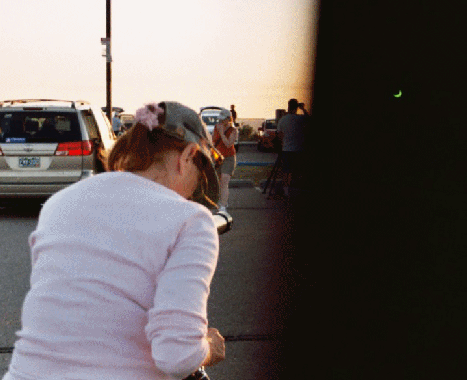
We watched the Moon leave the Sun's disc until the Sun
finally set at 8:08 p.m. With the Sun gone, we began the
process of taking the equipment apart and packing it for the
trip home. People were leaving quickly, depending on how much
equipment they had to pack. By the time we were done, it was
almost dark. We returned to the hotel to get an night's sleep.
The late television news had stories about people observing the
eclipse from parks all over Albuquerque.
The trip home was uneventful and we started unpacking the
equipment, knowing that we would be using it again in just two
weeks to observe the once-in-a-lifetime Transit of Venus. It
would be an exciting two weeks of astronomical events in the
desert southwest!
Here is a short video sequence of the eclipse:
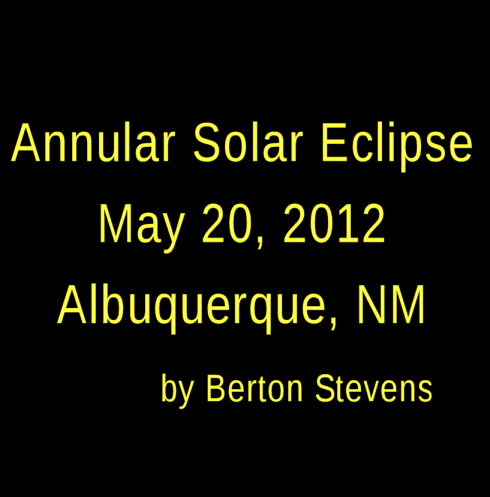
|
